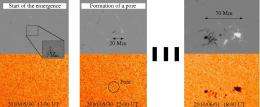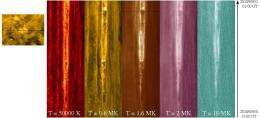Watching the birth of a sunspot

(PhysOrg.com) -- Researchers at the University of Central Lancashire have monitored the birth of a sunspot over a period of eight hours using observations from NASA's Solar Dynamics Observatory (SDO). Dr. Stephane Regnier presented the results at the RAS National Astronomy Meeting in Llandudno on Monday 18th April.
The emerging sunspot was first detectable at 17:00 UT on 30th May 2010 in SDO magnetograms, which map the magnetic intensity of the solar disc. The first signs were small patches of strong positive and negative magnetic field, separated by around 7 000 km.
"About 5 hours after the first signs of the eruption, the magnetic disturbance had grown to around 20 000 km across and we could see a pore form in the visible wavelength images next to the negative polarity." said Regnier. "By 18:00 UT on June 1st, the sunspots had appeared."

The photosphere is the visible surface of the Sun. Convection cells of hot, bright gas rising up to the surface are surrounded by sinking, cool, darker material, giving the photosphere a granular appearance. These granules are grouped into supergranules, which can be more than 20 000 kilometres across.
"The peculiarity of what we are seeing is that the pore emerges at the edge of a supergranular cell Models have predicted that we would see this at the cell center where the upflows are more significant," said Regnier.
The SDO observations allow Regnier to study temperature measurements ranging from 50000 to 10 million degrees Celsius on an almost second by second basis.
"In all temperature ranges, we can see the emerging area as a magnetic tube that is very hot at the edges and sharply delineated from the surrounding material. How sunspots are born, evolve and die is still a concern for solar physicists and one of the most intriguing subjects is to understand how these magnetic tubes can emerge from below the Sun's surface and push through into the hot atmosphere," said Regnier.
Provided by Royal Astronomical Society





















